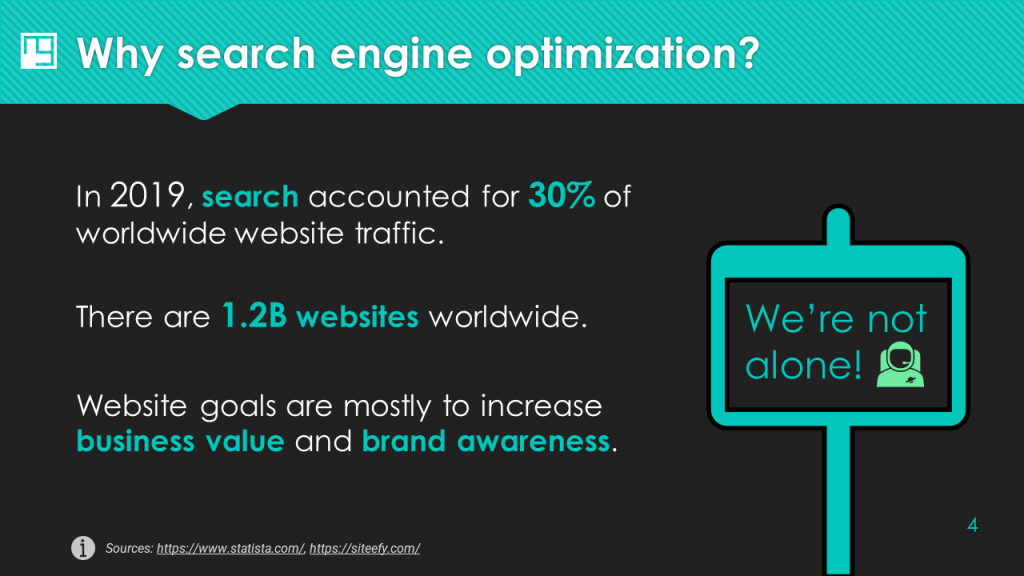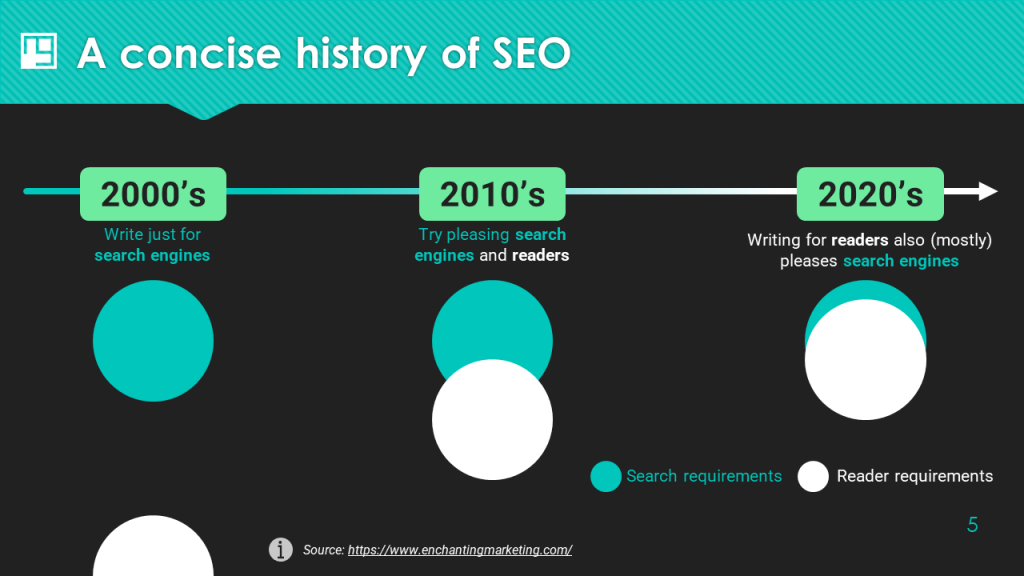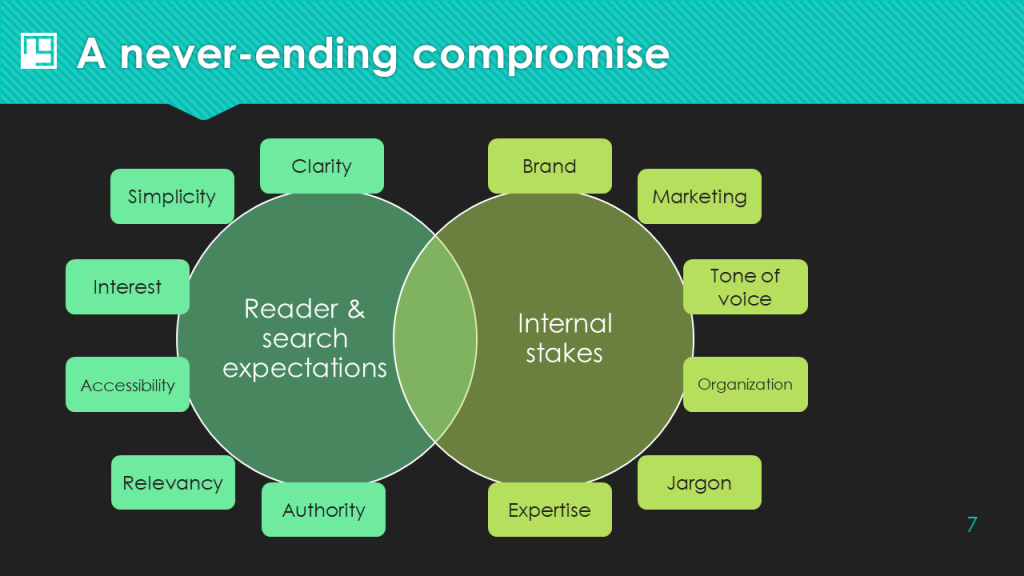Writing for the web is not rocket science. The web is full of valuable resources about the topic.
Here’s one more: I am sharing a recap of what I’ve learnt about it, til today:
- Why search is important?
- Why writing for the web is any different?
- The checklist to effectively write for the web
Not sure you’ll learn something new today. But I’ve put things together and I’m sharing advices on how to write for the web.
Why search engines are important?
A quick reminder: What is search engine optimization?
SEO is the practice of increasing the quality and quantity of traffic to your website through organic search engine results.

- On-Page SEO: It’s all about your content – in-depth, user-firendly, unique, authoritative and trustworthy, aligned with user search intent ; and your site – link quality, load speed, URL structure, mobile friendliness, page metadata.
- Off-Page SEO refers to actions taken outside of your site to impact your rankings within search engine results pages: backlinks, social media, guest blogging etc.
Search engine marketing (SEM) involves the promotion of websites by increasing their visibility in search engine results pages (SERPs) primarily through paid advertising.
SEM is the wider discipline that incorporates SEO.
Why does search matter?
Here are key facts.

- One third of worldwide website traffic started with a search query in 2019 according to Statista.
- Siteefy counts 1.2 billion websites. Strangely enough, it’s decreasing but let’s face it: we’re not alone!
- Most of these websites have the same goals: increase business value and raise brand awareness.
Be found from search engines can surely help. Hello search!
The evolution of search engine optimization over time
This is the SEO history part of my blog, largely inspired by Enchanting Marketing.

Coming back as far as in the 2000s.
Back then keyword you were keyword writing just for keyword keyword keyword search. Reader? What reader? Search wanted keywords keywords keywords. Ok, you got it.
Shortly after, the 2010s and the awareness of the reader. Because yes, as crazy at it sounds, search engine objective is to provide relevant results to readers. If readers are unhappy, not only they won’t come back to the suggested site, but they might try another search engine!
So let’s go away from hidden satellite pages and keyword stuffing and look a bit more at the site and page content.
And now the 2020s: algorithms are getting very sophisticated, almost able to read web content as a reader. With not a perfect sense of irony and humour, of course. But they’re getting close. How close? If you focus on good quality content, a bit of keyword research and site performance, that’s called good SEO.
Why writing for the web is any different from writing for printed materials?
Because we’re not reading web pages, we’re scanning.
According to a study from NN Group, a web reader is looking at 158 spots in just 14 seconds. The corresponding eye pattern is called the pinball pattern. It defines well the action ‘scanning content on a page’.

We need to focus on key points that allow better scanning:
- Use plain language. Ban jargon and ambiguous words. Avoid unusual words.
- Prefer short sentences. The most popular ponctuation mark should be the dot. Dot.
- Make the most of paragraph articulation. Start with what’s important. One paragraph = one idea.
- Think about an engaging layout. Clear content structure, visual highlights, images, links.
Writing for the web involves compromises
On one hand, we’d like to write content highly rated by readers and search.
On the other hand, we’ve got internal preferences to cope with.

Internal stakes can range from brand positioning, marketing messages to tone of voice – acting as guidelines to follow to represent the company values and style. But sometimes it can extend to internal organizational considerations, use of jargon related to the field of expertise we’re in.
What readers and search engines want? Clarity, relevancy, authority – understand the topic covered, why we’re talking about it and what we have to say. And of course well laid out content, valuable data, trusted sources – anything they can share to their network.
Find the right balance to please your audience while still being “you”.
Speak their language, challenge the status quo with jargon and own vocabulary.
The checklist to effectively write for the web
Here comes the checklist. A lot of good sense, really. Nothing crazy I think.
Not to take for granted forever; best practices evolve regularly, so I’ll keep it updated.

Preliminary work
- Identify a topic
- Choose a specific angle (don’t try to cover the topic at large)
- Brainstorm on key phrases
- Research key phrases to select relevant ones (not too vague, with low competition)
- Get trained on the publishing platform (to properly use meta and H1, H2 and H3 tags)
Writing for the web
- Define your story flow
- Fragment and create a logical structure (one paragraph = one idea)
- Think about a catchy title (using at least one key phrase)
- Write between 500 and 800 words (place key phrases naturally)
- Illustrate with pictures (don’t forget credits and alt text)
- Show data (and link your source)
Publishing and beyond
- Make the most of H1, H2 and H3 tags, styles etc.
- Fill in title and description metadata tags
- Define a reader friendly URL
- Think about cross-linking tactic (to and from)
- Check metrics (and learn from it)
- Revisit after 3-6 months (to maintain accuracy)
I hope you enjoyed the read – or shall I say I hope you enjoyed the scan!
Feel free to share your comments and feedback at nicolas@gutron.fr



0 commentaire